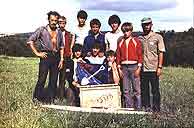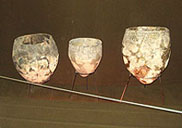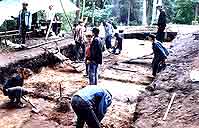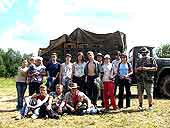Archeological Expeditions (page 1)
 The environs of the Trinity-St. Sergius Lavra were investigated in the course of two hundred years since Zorian Dolengo-Khodakovsky. In 1984, the archeological expedition of the Sergiev Posad Museum-Reserve (ZARE – the Zagorsk archeological expedition) started regular archeological investigation on the territory of the Moscow Region and neighboring areas. In 1990, there were organized the archeological sector and then the archeological department (managed by Dr V.I. Vishnevsky). They discovered 120 new monuments, some of the them were investigated by excavations.
The environs of the Trinity-St. Sergius Lavra were investigated in the course of two hundred years since Zorian Dolengo-Khodakovsky. In 1984, the archeological expedition of the Sergiev Posad Museum-Reserve (ZARE – the Zagorsk archeological expedition) started regular archeological investigation on the territory of the Moscow Region and neighboring areas. In 1990, there were organized the archeological sector and then the archeological department (managed by Dr V.I. Vishnevsky). They discovered 120 new monuments, some of the them were investigated by excavations.
 Zamostje 2 site provided rich material. There were founded arrowheads, scrapers (for cleaning skins), points, scrapers, grinders, drills, blades for insert tools, rough adzes, chisels, axes (for making hollow out boats), churingas (45 samples ). The cultural under the water layer of Zamostje 2 site contained stone, ceramics, bone and even wooden items. At Samotovino-1 site in the Mesolithic layer of Zamostje site insert tools - two daggers and a spear heard of bone and elk antler. They were most rare items in European Russia.
Zamostje 2 site provided rich material. There were founded arrowheads, scrapers (for cleaning skins), points, scrapers, grinders, drills, blades for insert tools, rough adzes, chisels, axes (for making hollow out boats), churingas (45 samples ). The cultural under the water layer of Zamostje 2 site contained stone, ceramics, bone and even wooden items. At Samotovino-1 site in the Mesolithic layer of Zamostje site insert tools - two daggers and a spear heard of bone and elk antler. They were most rare items in European Russia.
 Rare bronze age items were found during the excavations of several sites and burial fields. The male skull from tomb 1 of Kuz’mino burial field (village Kuz’mino of the Sergiev Posad District was carefully investigated by a famous Soviet anthropologist M.M. Gerasimov who used it as basis for his reconstruction of a male head of Fatjanovo culture (displayed at the archeological exhibition). The collections of the early Iron Age and early Middle Ages were found in the course of the excavations of Kikino hillfort on the Velya river. There were discovered iron spears, knives, awls together with bone tools and weapons. At Kikino hillfort there were found iron slag, clay nozzles – tubes to force air into a furnace, clay spoons to pour bronze which was used for decorations – pendants, ear-rings, plaques, rings, temple-rings, fastenings.
Rare bronze age items were found during the excavations of several sites and burial fields. The male skull from tomb 1 of Kuz’mino burial field (village Kuz’mino of the Sergiev Posad District was carefully investigated by a famous Soviet anthropologist M.M. Gerasimov who used it as basis for his reconstruction of a male head of Fatjanovo culture (displayed at the archeological exhibition). The collections of the early Iron Age and early Middle Ages were found in the course of the excavations of Kikino hillfort on the Velya river. There were discovered iron spears, knives, awls together with bone tools and weapons. At Kikino hillfort there were found iron slag, clay nozzles – tubes to force air into a furnace, clay spoons to pour bronze which was used for decorations – pendants, ear-rings, plaques, rings, temple-rings, fastenings.
 In 1996, expedition of the Sergiev Posad Museum discovered the Rat’kovo ground burial field on Dubna river. It, obviously, belonged to Medieval Finns - murome and merya. It was dated back to the 7th – 9th century and referred to rare burial fields of Djakovo culture. There were found various bronze “noise-making” decorations which were necessary elements of a female costume. The late Medieval collection was formed as the result of the excavations of Radonezh and other Old Russian settlements. There were found traditional 14th – 15th century Moscow clay toy: birds-whistles, horses-rattles - and various fragments of ceramics.
In 1996, expedition of the Sergiev Posad Museum discovered the Rat’kovo ground burial field on Dubna river. It, obviously, belonged to Medieval Finns - murome and merya. It was dated back to the 7th – 9th century and referred to rare burial fields of Djakovo culture. There were found various bronze “noise-making” decorations which were necessary elements of a female costume. The late Medieval collection was formed as the result of the excavations of Radonezh and other Old Russian settlements. There were found traditional 14th – 15th century Moscow clay toy: birds-whistles, horses-rattles - and various fragments of ceramics.
|


